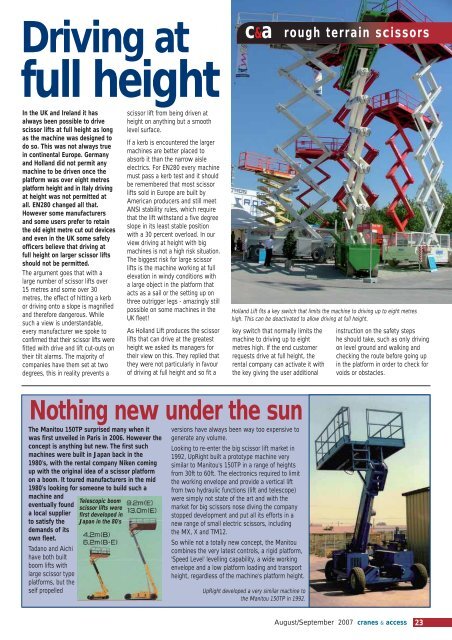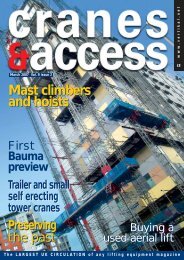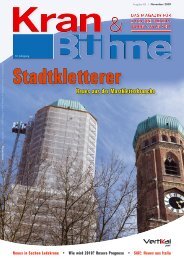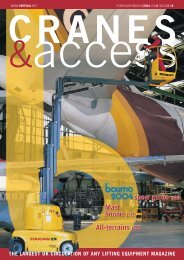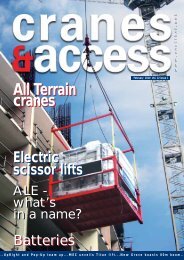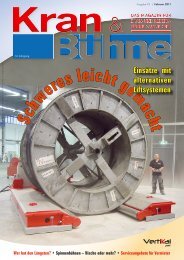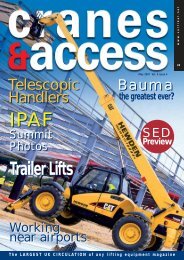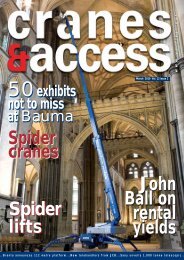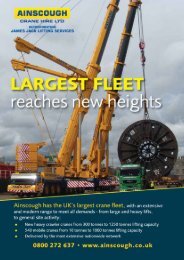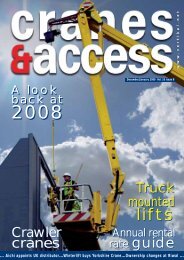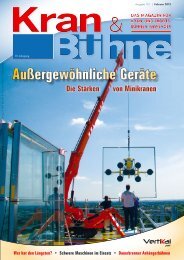c&a - Vertikal.net
c&a - Vertikal.net
c&a - Vertikal.net
Create successful ePaper yourself
Turn your PDF publications into a flip-book with our unique Google optimized e-Paper software.
Driving at<br />
full height<br />
In the UK and Ireland it has<br />
always been possible to drive<br />
scissor lifts at full height as long<br />
as the machine was designed to<br />
do so. This was not always true<br />
in continental Europe. Germany<br />
and Holland did not permit any<br />
machine to be driven once the<br />
platform was over eight metres<br />
platform height and in Italy driving<br />
at height was not permitted at<br />
all. EN280 changed all that.<br />
However some manufacturers<br />
and some users prefer to retain<br />
the old eight metre cut out devices<br />
and even in the UK some safety<br />
officers believe that driving at<br />
full height on larger scissor lifts<br />
should not be permitted.<br />
The argument goes that with a<br />
large number of scissor lifts over<br />
15 metres and some over 30<br />
metres, the effect of hitting a kerb<br />
or driving onto a slope is magnified<br />
and therefore dangerous. While<br />
such a view is understandable,<br />
every manufacturer we spoke to<br />
confirmed that their scissor lifts were<br />
fitted with drive and lift cut-outs on<br />
their tilt alarms. The majority of<br />
companies have them set at two<br />
degrees, this in reality prevents a<br />
The Manitou 150TP surprised many when it<br />
was first unveiled in Paris in 2006. However the<br />
concept is anything but new. The first such<br />
machines were built in Japan back in the<br />
1980's, with the rental company Niken coming<br />
up with the original idea of a scissor platform<br />
on a boom. It toured manufacturers in the mid<br />
1980's looking for someone to build such a<br />
machine and<br />
eventually found<br />
a local supplier<br />
to satisfy the<br />
demands of its<br />
own fleet.<br />
Tadano and Aichi<br />
have both built<br />
boom lifts with<br />
large scissor type<br />
platforms, but the<br />
self propelled<br />
scissor lift from being driven at<br />
height on anything but a smooth<br />
level surface.<br />
If a kerb is encountered the larger<br />
machines are better placed to<br />
absorb it than the narrow aisle<br />
electrics. For EN280 every machine<br />
must pass a kerb test and it should<br />
be remembered that most scissor<br />
lifts sold in Europe are built by<br />
American producers and still meet<br />
ANSI stability rules, which require<br />
that the lift withstand a five degree<br />
slope in its least stable position<br />
with a 30 percent overload. In our<br />
view driving at height with big<br />
machines is not a high risk situation.<br />
The biggest risk for large scissor<br />
lifts is the machine working at full<br />
elevation in windy conditions with<br />
a large object in the platform that<br />
acts as a sail or the setting up on<br />
three outrigger legs - amazingly still<br />
possible on some machines in the<br />
UK fleet!<br />
As Holland Lift produces the scissor<br />
lifts that can drive at the greatest<br />
height we asked its managers for<br />
their view on this. They replied that<br />
they were not particularly in favour<br />
of driving at full height and so fit a<br />
key switch that normally limits the<br />
machine to driving up to eight<br />
metres high. If the end customer<br />
requests drive at full height, the<br />
rental company can activate it with<br />
the key giving the user additional<br />
Nothing new under the sun<br />
Telescopic boom<br />
scissor lifts were<br />
first developed in<br />
Japan in the 80's<br />
c&a<br />
Holland Lift fits a key switch that limits the machine to driving up to eight metres<br />
high. This can be deactivated to allow driving at full height.<br />
versions have always been way too expensive to<br />
generate any volume.<br />
Looking to re-enter the big scissor lift market in<br />
1992, UpRight built a prototype machine very<br />
similar to Manitou's 150TP in a range of heights<br />
from 30ft to 60ft. The electronics required to limit<br />
the working envelope and provide a vertical lift<br />
from two hydraulic functions (lift and telescope)<br />
were simply not state of the art and with the<br />
market for big scissors nose diving the company<br />
stopped development and put all its efforts in a<br />
new range of small electric scissors, including<br />
the MX, X and TM12.<br />
So while not a totally new concept, the Manitou<br />
combines the very latest controls, a rigid platform,<br />
'Speed Level' levelling capability, a wide working<br />
envelope and a low platform loading and transport<br />
height, regardless of the machine's platform height.<br />
UpRight developed a very similar machine to<br />
the Manitou 150TP in 1992.<br />
rough terrain scissors<br />
instruction on the safety steps<br />
he should take, such as only driving<br />
on level ground and walking and<br />
checking the route before going up<br />
in the platform in order to check for<br />
voids or obstacles.<br />
August/September 2007 cranes & access<br />
23


